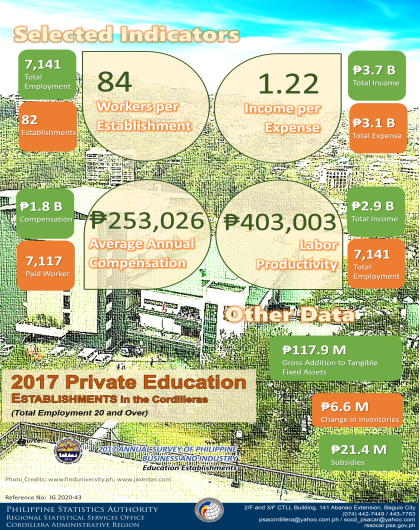Secondary education has the most share of establishments
- Preliminary results of the 2016 ASPBI conducted nationwide showed a total of 3,722 establishments was recorded with total employment (TE) of 20 and over. This recorded an increase by 4.3% compared to 3,568 establishments in 2015.
- Secondary/high school registered the most establishments with 1,570 or 42.2 percent. Higher education sector followed with 1,294 establishments (34.8%) while pre-primary/pre-school education had the least with 149 establishments (4.0%).
- Pre-primary and primary schools increased by 10.9 percent from 558 establishments in 2015 to 619 establishments in 2016. A slight increase also was seen in secondary and higher education establishments by 2.1 percent, with a combined count of 2,864 in 2016.
- Educational support and other education services recorded a 16.6-percent increment with a combined 239 establishments in 2016, an additional of 34 more establishments.
Table 1. Number and percentage distribution of education establishments by sector, Philippines: 2015 and 2016
- On the regional level, National Capital Region (NCR) remained with the greatest number of educational establishments with 841 (22.6%). This recorded an increment of 30 schools and educational establishments from 2015.
-
CALABARZON followed with 702 educational establishments (18.9%) while Central Luzon ranked third with 464 establishments (12.5%). Establishments in these regions exhibited minimal increases by 3.1 percent and 1.5 percent, respectively.
-
A significant boost of schools and other educational services was evident in Central Visayas with 52 more schools from 231 establishments in 2015, an increase of 22.5 percent. No increases were seen in Negros Island and Autonomous Region of Muslim Mindanao in a year’s span, still with 47 and 113 educational establishments, respectively.
- A total of 276,542 persons were working in the education industry in 2016, wherein 98.8 percent were paid employees and the remaining were working owners and unpaid workers. The sector had a boost of 10,729 manpower from 2016, or an increase of 4.0 percent in a year’s span.
- More than half of the total employment (58.8%) or 162,675 were in the higher education sector, followed by secondary education with 77,157 employees (27.9%). Primary/elementary education ranked third with 17,095 employees (6.2%). Pre-school education had the least number with 5,074 (1.8%).
- Primary education sector had the biggest increase in percentage from a year ago by 10.2 percent or 1,579 employees more in 2016. With the continuing implementation of the K-12 curriculum, the secondary education establishments gained an additional manpower of 4,163 workers or 5.7 percent more from 2015.
- On the regional level, National Capital Region (NCR) still remained with the highest employment with 80,146 (22.6%). Followed by CALABARZON with 42,254 total employees (18.9%). Central Luzon ranked third with 28,151 employees (12.5%). Autonomous Region in Muslim Mindanao (ARMM) had the least with a total of 2,994 total employees (1.3%) in private educational establishments.
Figure 2. Distribution of total employment by education sector, Philippines: 2016
- Total employment among private educational establishments declined in regions Caraga (13.8%) Northern Mindanao (5.2%), Central Luzon (5.0%) and Bicol (2.0%), while a noticeable increase in workers were recorded in Central Visayas establishments (32.9%), all in a year’s period.
Employees of educational support services are the highest paid
- Total compensation paid by education sector amounted to PHP 72.1 billion, translating to an average annual compensation of PHP 263,831 per paid employee.
- Across industry group, higher education services paid the highest average annual compensation of PHP301,411 per paid employee, followed by other educational support services with PHP226,787 average pay per year. On the other hand, employees of establishments providing primary education had the lowest average annual pay of PHP167,633.
- Among regions, NCR had the largest share of compensation, with PHP31.0 billion, translating to an average annual compensation of PHP387,609 per paid employee. Cordillera Administrative Region (CAR) and Negros Island Region followed, with an average annual compensation of PHP255,048 and PHP245,000 per employee, respectively. Autonomous Region in Muslim Mindanao (ARMM) recorded the least average annual compensation of only PHP155,785 per worker.
- Compensation in the industry was 51.1 percent of the total expense spent by education establishments in 2016. Expenditures to pay education workers had an increment of 4.5 percent from 2015.
Figure 4. Average annual compensation per paid employees by industry group, Philippines: 2016 (in thousands)
- Subsidies from government to education establishments in 2016 reached PHP2.5 billion. Secondary/high school education received the highest grant from the government amounting to PHP1.4 billion (57.48%), followed by higher education with PHP743.5 million or 29.8 percent share of the total subsidies for the sector. The least subsidy was received by pre-primary/pre-school education amounting to PHP4.71 million (0.19%).
- All the regions received subsidies from the government in 2016. CALABARZON was granted the largest with PHP458.0 million, followed by Central Luzon with PHP432.8 million and NCR as third with PHP401.70 million. Negros Island region got the least subsidy with PHP11.0 million.
TECHNICAL NOTES


